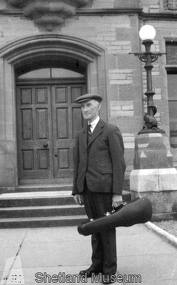Annotation:Kiss Her and Clap Her
X:1 T:Kiss Her and Clap Her M:6/8 L:1/8 S:Peter Fraser B:Anderson & Georgeson - Da Mirrie Dancers K:Amix B|:c2e (ecA)|(AcA) {g}f2-e|(dBG) G2g|(dBG) (BdB)| c2e (ecA)|(ecA) e2c|(def) g2e|(dBG) BdB:| |:(ABA) a2-a|(ecA) a3|A2(g a2a)|g2e (dBG)| (ABA)a2a|(ecA) (efg)|{g}(fef) (def)|g2e dBG:|]
KISS HER AND CLAP HER. Shetland, Wedding Tune (6/8 time). A Mixolydian. Standard tuning (fiddle). AABB. The title means 'kiss her and pet her'. This was the second tune usually played for the wedding party in a traditional Shetland wedding of the last century; it "was a cue for the groom's party to kiss the bridesmaids ceremonially" (Cooke, 1986). Allan Cunningham (Songs of Scotland, Ancient and Modern, 1825, p. 294) discusses the song "Here Awa, There Awa, Wandering Willie," (which appears in the first volume of Johnson's Scots Musical Museum) and notes:
In copying this old song from Johnson's Museum, I excluded a strange verse which had been attached to the others, more for the sake of the uncouth contrast than with the wish of continuing the song in its natural character. The verse nevertheless has claims upon our regard from its undoubted antiquity, and from its being all that time has left us of the original 'Haud awa' Home'. It is worth preserving.
Gin ye meet my love, kiss her and clap her,
Gin ye meet my love, dinna think shame—
Gin ye meet my love, kiss her and clap her,
And show her the way to 'haud awa' hame.
Although there is no documented connection, the similiarity of Fraser's title and the 'Haud awa' lines above is evident. Poet Robert Burns did not originally contribute the song, but in his subsequent work with Johnson he requested the above lines be added, writing in a letter from a brief sojourn to Newcastle:
These (i.e. the above) lines will set to the tune thus than as they are printed. To the song in the first Volume, Here Awa' There Awa', must be added this verse, the best in the song.
Melodies that have historically been set to Burns' song, however, bear no similarity to the Shetland tune.
Tom Anderson & Tom Georgeson, in their 1970 Da Mirrie Dancers note:
The traditional role of the fiddler at weddings in Shetland has already been mentioned. In addition to dance music, including that for the ritually important Bride's Reels, the fiddler was required to provide music at several other points in the rite. Peter Fraser, in his dialect account of an 'Old Time Shetland Wedding', a description of the last old style wedding in his parish over 50 (70) years ago (Shetland Folk Book, vol. 2, 1957), mentioned five tunes that were required for the ritual in his district. As a fiddler himself, he knew all the tunes and communicated them to the Swedish researcher, Otto Andersson, in the 1930s. As a member of the Shetland Folk Society, Peter Fraser also introduced them to members of the Shetland fiddle band and recorded them for their principal collector, Tom Anderson.


